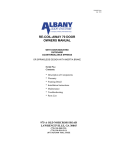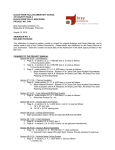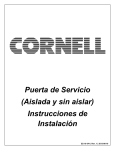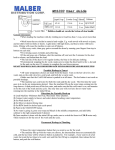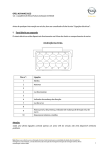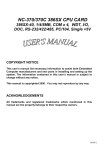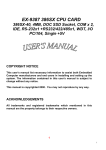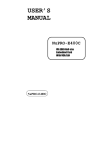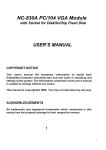Download WD1000 Installation Manual
Transcript
Rubber Door System INSTALLATION INSTRUCTIONS WD 1000 RUBBER DOOR ________ WIDE x ________ HIGH WARREN DOOR SALES “THE INDUSTRIAL SALES PEOPLE” P.O. BOX 70 332 PLANT STREET NILES, OHIO 44446 TELEPHONE: 1-800-ALL DOOR (1-800-255-3667) FAX: 330-652-5939 Table of Contents Forward 3 1. Limited Warranty 4 2. Features 2.1 Standard Features 2.2 Optional Features 5 5 3. WD 1000 General Door Arrangement Drawing 6 4. Components 4.1 Guides 4.2 Drive End Bracket 4.3 Spring End Bracket 4.4 Counterbalance Spring Barrel 4.5 Curtain 4.6 Idler Barrel 4.7 Charging Wheel 4.8 Bottom Bar 4.9 Electric Operator 7 7 7 7 7 8 8 8 8 5. Erection Instructions 5.1 Set up prior to erection (Drawing A) 5.2 Guides (Drawing B.) 5.3 End Brackets (Drawing C) 5.4 Spring Barrel and Curtain 5.5 Electric Operator (Drawing E) 5.6 Charging Wheel and Pre-Charge (Drawing F) 5.7 Idler Barrel 5.8 Operator Electrical Connection 5.9 Hood Cover 9-10 11-12 13-15 16 16-17 18-19 20 21 21 6. Maintenance Guide 22 7. Curtain Removal and Re-installation 7.1 Remove from guide system 7.2 Reinstallation of curtain after an impact has Removed the curtain from the guide system. 23 23 8. Parts List 8.1 Guide Assembly (Drawing J.) 8.2 Charging Wheel & End Bracket Assembly (Drawing K) 8.3 Drive End Bracket Assembly (Drawing L) 24 25 24 & 26 24 & 27 FORWARD THE INFORMATION CONTAINED IN THIS DOCUMENT IS SUBJECT TO CHANGE WITHOUT NOTICE!!! Warren Door provides this information as a service to its customers. We strongly recommend that you review and study the information provided. Your complete understanding of the door system and its requirements is a priority and will allow you to enjoy the unique design features of the WD 1000. If you have any questions regarding the following instructions, contact the factory before proceeding. Any deviation from the following instructions will result in improper operation of the door system, damage to the rubber curtain or its components, and will void the warranty extended by Warren Door of its parts manufactures. REMEMBER IT IS EASIER TO HANDLE QUESTIONS THAN IT IS TO HANDLE UNNECESSARY MISTAKES. WARREN DOOR SALES LIMITED WARRANTY ALL RUBBER DOOR SYSTEMS MANUFACTURED BY WARREN DOOR ARE WARRANTED AGAINST DEFECTS IN MATERIALS AND WORKMANSHIP AS FOLLOWS: DOOR SYSTEMS IN GENERAL-ONE (1) YEAR FROM THE DATE OF PURCHASE; RUBBER CURTAIN – FIVE (5) YEARS FROM THE DATE OF PURCHASE. THIS WARRANTY COVERS DEFECTIVE MATERIAL AND WORKMANSHIP. THE WARRANTY APPLIES ONLY IF THE RECOMMENDED INSTALLATION AND MAINTENANCE PROCEDURES OUTLINED IN OUR SERVICE MANUAL AND INSTALLATION BOOK ARE STRICTLY FOLLOWED. CONTACT WARREN DOOR FOR A LIST OF TRAINED INSTALLERS IN YOUR AREA. DEFECTIVE PARTS MUST BE RETURNED TO OUR SHOP, FREIGHT PREPAID, ACCOMPANIED BY A COPY OF OUR INVOICE FOR OUR INSPECTION AND DETERMINATION. WE DO NOT AUTHORIZE AND WILL NOT PAY FOR ANY OUTSIDE REPAIR. OUR OBLIGATION UNDER THIS WARRANTY SHALL BE LIMITED TO, AS WE MAY ELECT, EITHER REPLACEMENT OF ANY DEFECTIVE PARTS FREE OF CHARGE OR PAYMENT EQUAL TO THE COST OF REPAIR BASED ON OUR ESTIMATE AND JUDGMENT. WE SHALL NOT BE LIABLE FOR ANY LABOR CHARGES, TOWING CHARGES, LOSS OF TIME CHARGES, NOR ANY OTHER CHARGES. THIS IS OUR ONLY WARRANTY. IN CASES WHERE THE MANUFACTURER’S WARRANTY OF CERTAIN COMPONENT PARTS CONNECTED WITH OUR DOOR SYSTEMS (I.E., ELECTRICAL MOTORS, SWITCHES, ETC.) IS LESS THAN THE WARREN DOOR WARRANTY, THE MANUFACTURER’S WARRANTY WILL APPLY. THE WARREN DOOR WARRANTY DOES NOT INCLUDE REPLACEMENT OF PARTS DUE TO NORMAL WEAR AND TEAR, DAMAGE BEYOND THE CONTROL OF WARREN DOOR (I.E.., DAMAGE IN TRANSIT, IMPACTS, ETC.) OR ANY LABOR CHARGES INCURRED ON THE REMOVAL AND/OR REPLACEMENT OF DEFECTIVE PARTS. ALL WARRANTY CLAIMS MUST BE MADE TO WARREN DOOR. ALL RETURNS MUST BE SHIPPED “PREPAID FREIGHT” TO: WARREN DOOR 332 PLANT STREET NILES, OHIO 44446 DO NOT EVER USE PETROLEUM BASED PRODUCTS ON THE CURTAIN. IF DONE, THIS VOIDS ALL WARRANTY ON THE CURTAIN. FEATURES 2.1 STANDARD FEATURES 1. 2. 3. 4. 5. 6. 7. 8. 9. 10. 11. 12. 13. American Made door components and power operator. Rubber Curtain. WD Safety bottom bar. Electric reversing safety edge. Guides. Hood. Idler barrel. Counterbalance spring barrel. End Brackets. Complete standard mounting hardware package. NEMA I interior open-close-stop push button station. NEMA I 1hp (or 2hp) power operator depending on curtain size. 1 Set of Photo-eyes. 2.2 OPTIONAL EQUIPMENT (Listed, but not limited to) 1. 2. 3. 4. 5. 6. 7. 8. 9. 10. 11. 12. Chain Hoist Operation. Pneumatic Safety Edge. Windows. Various NEMA Requirements. Radio Controls. Time Delay Controls Key Switch. Ceiling Pull Switch. Card Reader. Vehicle Detector. Stainless Steel. Galvanized Steel. 4. COMPONENTS 4.1 GUIDES The guides are pre-engineered to corresponding door heights that, when placed vertically on each side of the opening, direct the rubber curtain’s travel and manage how the wind-lock of the curtain reacts during impact and wind pressure. The top portions of the guides are hinged to allow the curtain to be re-inserted should it be pulled out of the guides. 4.2 DRIVE END BRACKET The drive end bracket is mounted to the top of the guide system that holds it to the face of the door opening. This bracket supports the operating device, counterbalance spring barrel, idler barrel and bearings. 4.3 SPRING END BRACKET The spring end bracket is mounted to the top of the opposite guide as the drive end bracket. The guide system holds the spring end bracket to the face of the door opening. This bracket has a slotted channel attached to it in which the charging wheel keeper pin is placed to retain tension on the counterbalance spring barrel. This bracket also supports the counterbalance spring barrel, idler barrel and bearings. 4.4 COUNTERBALANCE SPRING BARREL This counterbalance spring barrel is constructed of a steel barrel that contains helically wound torsion springs. This barrel is enclosed with end plugs on the drive end and spring end that holds the pipe concentric to the shaft. The counterbalance spring has sufficiently sized springs to help lift the weight of the curtain during operation. The counterbalance spring barrel allows an anchoring point to which the top of the curtain is secured to. 4.5 CURTAIN The curtain is a ¼” nominal S.B.R. (Styrene Butadiene Rubber) R.M.A. Grade II material with R.M.A. Grade II Covers. A ½” R.M.A. Grade II material is attached to the curtain to form beveled wind-locks. This wind-lock is designed to react in specific ways during impact and to help maximize the thermal properties of the door system. 4.6 IDLER BARREL The idler barrel is constructed of a steel tube with end plugs on either end that support the shaft. This shaft attaches the idler barrel to the end bracket and mounts into the pillow block bearings. The idler barrel maintains the curtain position in relationship to the lintel of the opening. This “curtain to lintel” relationship helps the door system’s thermal control properties. 4.7 CHARGING WHEEL The charging wheel mounts to the spring end of the counterbalance spring barrel shaft and is held in place with a keeper pin. The charging wheel allows tension to be placed on the torsion springs and is held by a charging wheel keeper pin placed through a slotted channel block on the spring end bracket. 4.8 BOTTOM BAR The bottom bar is an angle and flat steel component that leads the curtain in the guide system. It contains a safety notch with a span plate that allows the bottom bar to react during impacts, and insures proper performance of the wind-lock during impacts. The bottom bar also holds either a standard electric safety edge or an optional pneumatic safety edge. 4.9 ELECTRIC OPERATOR The electric operator is a NEMA I unit that consists of a NEMA 1 factory prewired control panel, a fully adjustable traveling cam type limit switch, a continuous duty tri-voltage motor, shock absorbing couplings, an emergency operation hand chain, a heavy duty worm and gear reducer running in an oil bath, an interior 3 button push button station and a solenoid operated brake design. 5. ERECTION INSTRUCTIONS SEE DOOR GENERAL ARRANGEMENT DRAWING WD1000 5.1 SET UP PRIOR TO INSTALLATION * NOTE: It is absolutely vital to the proper operation of the door that the guides be erected according to the strict instructions provided. Any deviation from these instructions will cause the WD 1000 to operate improperly and cause damage to its components. If you have any questions or need clarification please contact the factory at: 1-800-ALLDOOR (1-800-255-3667). a. Determine that the opening jambs are true by measuring the width at the lintel line and the floor level. These dimensions should be equal (only ¼” maximum tolerance). b. Check the measurements of the opening to the width and height of the door ordered. (See Drawing A.) The guides must be spaced horizontally by the given “C” dimension (shown on the General Arrangement Drawing WD1000) and must be set plumb. c. Ensure that the jambs are perpendicular by using a proper level. d. At the ends of the lintel measure from the underside of the lintel to the floor of the opening. There should be no more than ½” difference between the opening measurement and the height of the door ordered. e. Finally, using a level or transit, make a horizontal line across the opening to ensure the guides are level when installed. * NOTES: If any of the measurements exceed the maximum tolerances specified CONTACT THE FACTORY BEFORE PROCEEDING WITH THE INSTALLATION! DO NOT remove the straps from the curtain until instructed to do so. By leaving the straps on, your job will be made easier during the installation. 5.2 STEP I: ERECTION OF GUIDES a. The guides for the door systems are marked “left guide” and “right guide”. These guides are pre-assembled and do not require disassembly prior to installation. b. Refer to Drawing B. Place the Left Guide (with hinged portion facing out) flush with the inside edge of the steel column or frame on the left side of the opening. Position the top of the retainer to correspond with the mark line 6” above the underside of the lintel. Ensuring that the guide is exactly perpendicular, attach it to the steel column of the frame by tack welding (using approximately 12” centers) to guide leg and lag bolt to the wall. c. Repeat step b with the Right Side. d. The clearance of ½” or 9/16” in the guide opening (see arrangement drawing WD1000) has been determined at the factory. It allows the curtain to move freely within the guides. However, during shipment or assembly, the guide opening may have been altered so we recommend that you pass a ½” or 9/16” bolt through the guide opening to verify that the opening is not too wide or too narrow for the curtain to pass. Any deviation from this measurement could result in damage to the curtain or reduction in the wind load capacity of the door. If variations do exist in the opening of the guide, such as being too narrow, simply spread the opening with a pry bar. If the opening is too wide, strike the outside section of the guide using a block or hammer. e. Unbolt the hinged portion at the top of the guides so that the swinging part of the guide is completely opened. This will make it easier to insert the curtain later in the installation process. Congratulations! The installation of the guides is complete. It would be to your benefit to briefly review your work at this point to ensure proper installation of the guide system. 5.3 STEP II: PLACEMENT OF END BRACKETS a. The end brackets are the flat steel plates that are shaped in somewhat of an octagon shape. Your components should include two of these brackets. Carefully slide the two end brackets onto the shafts of the counterbalance spring barrel. Reference Drawing C. The end bracket that has the slotted “c” channel piece welded perpendicular to the plate is the end bracket that goes on the winding wheel side. The other end bracket will then slide over the shaft at the other end of the counterbalance spring barrel; this is the driven side of the door. *NOTE: The set screws are NOT to be tightened down at this point in time. b. NOTE: It will work to your advantage during installation if you position the bottom bar between the counterbalance spring barrel and the wall while lowering the assembly into the guides. At this point remove the nuts and washers from the guide angle bracket studs if attached. c. Using a device sufficient to raise the weight of the door, position the spring barrel (with the curtain end bracket assemblies) until it is above the guide angles. Lower the assembly until the brackets rest on the angle shelf above the guides. Bolt the brackets to the top of the guides. Bolt the brackets to the guide angles (heads of the bolts should be on the inside to permit the curtain clearance). Replace the washers and nuts on the bracket studs. 5.4 STEP III: PLACEMENT OF SPRING BARREL & CURTAIN. a. With the curtain and end brackets in place, use a plumb line across the two end brackets to insure that the door is level. End brackets can be repositioned by loosening bolts and adjusting up or down within the slotted holes. The end bracket support on the top of the guide angle may require shimming. b. Center the curtain between the end brackets and tighten the bearing screws. 5.5 STEP IV: PLACEMENT OF ELECTRIC OPERATOR a. Hand Tighten the operator mounting bracket to the drive end bracket. b. Bolt the operator unit to the operator mounting bracket with the four (4) bolts provided. c. Remove the cover from the operator limit box, (See Drawing E). If the “open” limit switch is not already actuated, engage the chain hoist on the operator and manually turn until the open limit is actuated. Leave the cover off in case further adjustments need to be made. d. Place the larger driven sprocket on the operator end of the counterbalance spring barrel shaft. e. Place the smaller drive sprocket on the operator drive shaft if not already placed. f. Attach the chain around the two sprockets, insure proper alignment of chain, and tighten each set screw. Adjust the slack in the chain (insure that the amount of slack does not exceed ¼” by moving the operator unit. Tighten the two (2) mounting bolts left hand tightened in step 5.5-a. OPERATOR MOUNTING IS NOW COMPLETE. AS IN PREVIOUS STEPS, CHECK YOUR WORK FOR ACCURACY! 5.6 STEP V: CHARGING WHEEL PLACEMENT AND PRECHARGING OF COUNTER BALANCE SPRING BARREL. a. Place the charging wheel on the spring end bracket side of the counterbalance spring barrel shaft. Rotate the wheel by hand to determine the spot where there is no tension on the springs, this is your neutral point. b. Insert the charging wheel keeper in the slotted angle with the button head up on the top of the channel. Then slip the pin into the nearest hole of the charging wheel and mark that charging slot to indicate the initial starting point of charging wheel. *THE REQUIRED NUMBER OF CHARGING WHEEL TURNS ARE ________ FOR THIS DOOR. (See Drawing “F”) c. Insert the winding bar into a hole in the charging wheel. Apply pressure to the tension rod in the direction of the arrow on drawing “F”. While continuing to apply pressure on the rod, remove the charging wheel keeper pin, rotate the charging wheel in the direction of the arrow – one hole – and reinsert the charging wheel keeper pin. You are now ready to fully charge the counterbalance spring barrel. Keep tension on the charging wheel again and remove the charging wheel keeper pin. By using the mark that was made on the charging wheel, turn the charging wheel the necessary number of turns and replace the charging wheel keeper pin. BE CAREFUL NOT TO TRY AND TURN THE CHARGING WHEEL TOO MUCH AT ONE TIME. IF YOUR GRIP ON THE TENSION RODS WOULD SLIP, SERIOUS INJURY COULD RESULT. The pre-charging of the counterbalance spring barrel is complete. Once again review your work for accuracy. Any deviation from the specified charging instructions will cause the door to work improperly and may cause damage to the door system components. 5.7 STEP VI: PLACEMENT OF IDLER BARREL a. Remove the shipping straps from the door curtain. b. Use the manual chain hoist to lower the curtain into the guide system, two (2) feet below the lintel. c. Place two (2) bearings, one on each side, of the idler barrel shaft. Raise the idler barrel with bearings under the curtain and into the slotted portion of the end brackets. Bolt the bearings to the end of the brackets with the heads of the bolts on the inside of the brackets. Now bolt the rest of the pillow block holes using the special rectangular washers furnished through the guide angle bolting. d. Position the roll equal distance between each end bracket and tighten bearing set screws. e. Lower the curtain into the guide system 18” below the hinged guide sections. Close the hinged guide retainers and bolt sections to the guide angle. The distance between the curtain and the wall is 1”. (If the clearance tolerances are not within the specifications the clearance can be adjusted by loosening the bolts on the idler barrel bearings and moving the idler barrel the proper direction. After adjustment is made, tighten the bearing bolts again and recheck clearance measurement). f. It is necessary at this point to check the tracking of the curtain inside the guide system. Unbolt one of the hinged guide sections. While keeping your attention on the outer edge of the curtain, lower the curtain with the chain hoist and observe the travel of the curtain. If the curtain tracks to either side of the guide, it is necessary to realign the counterbalance spring barrel. To do this, simply raise or lower the counterbalance spring barrel. After operating the door again by chain hoist and it is determined that the curtain is tracking properly, bolt the hinged portion of the guide system again to the mounting angle. THE PLACEMENT OF THE IDLER BARREL IS NOW COMPLETE. AGAIN REVIEW YOUR WORK TO INSURE THAT YOU HAVE COMPLETED THE STEPS PROPERLY. 5.8 STEP VII: OPERATOR ELECTRICAL CONNECTION a. Connecting to the power supply. Consult local electrical codes before proceeding with permanent installation. WARNING: Exercise caution when engaging electrical operator. The drive and limiting chains are exposed and if turning, could cause injury. Wiring diagrams can be found inside the control box cover and install the control stations as required. On Three phase units, make certain that the operator rotates in the correct direction. If the direction is wrong, the limit switches will not function and damage will occur to the door. It is strongly recommended that the door be moved manually to mid-position before turning the power on so that it may be stopped before any damage can occur should the rotation be incorrect. If the direction is incorrect, reverse any two (2) of the three (3) incoming power supply leads to correct rotation. b. Limit switch adjustment Depress traveling cam retaining bracket to turn traveling limit nuts. Turning the traveling limiting nut away from the open limit switch and toward the center of the cam shaft increases upward door travel. Turning traveling limit toward the open limit and away from the center of the cam shaft decreases upward travel of the door. Make sure that the retaining bracket engages in slot after each adjustment. Use the STOP button to stop the door until limits are set in the correct position. 5.9 STEP VIII: HOOD COVER PLACEMENT a. b. For a one piece cover, set the hood on top of the bracket with the top flange of the hood tight against the wall. Drill six (6) spaced holes in the supporting angle on the end brackets and anchor with the self tapping screws provided. For a two or more piece hood cover, fasten cover support(s) to the wall on equal centers, and attach the hood cover to the end brackets and the supports as described in 5.9-a. THE DOOR INSTALLATION IS NOW COMPLETE. 6. Maintenance While the WD1000 has been designed to help eliminate maintenance requirements traditionally required by conventional door systems, by implementing the following minor maintenance checks you will get the maximum life from your new rubber door. a. Door Assembly All external bearings should be greased via the attached fitting at least once a year. Standard wheel bearing grease is recommended. b. Electric Operator To help extend life, the drive chain should be lubricated once a month. Also the slack should be checked and should not exceed ¼”. If the slack exceeds ¼” tighten the chain by adjusting the position of the power operator. (See 5.5 Step IV: Placement of Power Operator for instructions). Check the level of oil in the power operator reducer once a year to insure that no leaks have developed in the oil seals. Check the wiring connections and power supply wiring for continuity once a year. c. Guides Check to insure that the clearance in the guide opening is maintained at the specified width, ½” or 9/16”. This should be checked every three months by passing a ½” or 9/16” bolt through the guide opening. If the clearance is too narrow, spread the opening to the correct width. If the clearance is too wide, strike the outside of the windlock guide using a block or hammer. d. Curtain In the unlikely event that a curtain should tear, it possibly, may be addressed in the field, depending on the severity. Consult our engineering office for the details on the rubber curtain repair kit at 1-800-2553667. DO NOT EVER USE PETROLEUM BASED PRODUCTS ON THE CURTAIN. IF DONE, THIS VOIDS ALL WARRANTY ON THE CURTAIN. 7. CURTAIN REMOVAL AND REINSTALLATION 7.1 REMOVAL FROM THE GUIDE SYSTEM If it becomes necessary to remove the curtain from the guide system, use the following process: 7.2 a. Unbolt the top hinged section of the guide system. b. Raise the curtain until the bottom bar is at the bottom portion of the hinged section. c. Lift the curtain and remove it from the guide system. d. Lower the curtain and make sure that it does not hang up on any part of the guide system. (Reverse this order to re-install.) REINSTALLATION AFTER AN IMPACT HAS REMOVED THE CURTAIN FROM THE GUIDE SYSTEM a. Straighten the bottom bar assembly and replace the span plate as well on all sheared span plate bolts. b. Raise the curtain to the hinged portion of the guide system. c. Unbolt the hinged portion of the guide system and open fully. Place the curtain into the guide system, lower the curtain two (2) feet into the guide system, then close the hinged portions and replace the bolts. 8. PARTS 8.2 PARTS LIST – CHARGING WHEEL END BRACKET ASSEMBLY – DRAWING K (For door heights 16’0” and under) Item # Description 1 End Bracket - LH End Bracket - RH 2 Flanged Bearings 3 Washer 4 Brg. Bolt, L.W. & Nut 5 Brg. Bolt, L.W. & Nut 6 Charging Wheel 7 Locking Pin 8 Charging Pin Bracket Part # # Required WD-104A 1 WD-104AA 1 WD-108C 2 WD-104B 1 WD-114 2 WD-114 2 WD-108E 1 WD-108H 1 WD-107C 1 PARTS LIST – CHARGING WHEEL END BRACKET ASSEMBLY (For door heights greater than 16’0”) Item # Description Part # # Required 1 End Bracket – LH WD-104AB 1 End Bracket – RH WD-104AC 1 (Items 2 through 8 are the same as above) 8.3 PARTS LIST – DRIVE END BRACKET ASSEMBLY – DRAWING L – (For door heights 16’0” and under) Item # Description 1 End Bracket – LH End Bracket – RH 2 Flanged Bearings 3 Washer 4 Brg.Bolt, L.W. & Nut 5 Brg.Bolt, L.W. & Nut Part # # Required WD-104A 1 WD-104AA 1 WD-108C 2 WD-104B 1 WD-114 2 WD-114 2 PARTS LIST – DRIVE END BRACKET ASSEMBLY – (For door heights greater than 16’0” Item # Description Part # # Required 1 End Bracket – LH WD-104AB 1 End Bracket – RH WD-104AC 1 (Items 2 through 5 are the same as above)

















